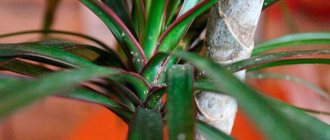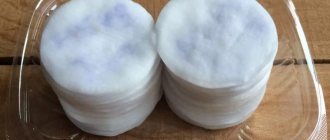Photo gallery
Formation of dracaena. Filling the cut with paraffin.
It is unpretentious in care; the only aspect that can cause difficulties when growing it is pruning, which must be done regularly.
Why do you prune dracaena?
There are three main reasons why dracaena is pruned:
- sanitary and preventive, in which all damaged leaves and shoots are cut off to stop the spread of the disease;
- decorative, in which a crown is formed;
- if the dracaena has grown to the ceiling.
To obtain side shoots and rejuvenate dracaena, decorative pruning is also used, giving the plant a well-groomed appearance and the necessary splendor. In addition, pruning is used as one of the methods of propagating dracaena, the cuttings of which take root quite quickly and successfully.
How to grow dracaena with a thick trunk
Dracaena (Dracaena marginata) is one of the most unpretentious indoor plants.
Pots with dracaena can be placed on a windowsill, as a flower stand, and dracaena also looks impressive as an outdoor plant. Dracaena grows well in parts of the room not illuminated by sunlight, only under artificial light.
When the earthen clod dries out, the dracaena leaves droop - this is how it signals the need for moisture. Once saturated, the leaves literally rise before our eyes, returning to their previous position.
Dracaena grows very quickly. If the plant has outgrown and its trunk is exposed, it can be formed. Stores often sell dracaenas with two or three fountains of shoots at the top. Sometimes a composition in a pot consists of several cuttings formed into one, two or three trunks, planted in one pot.
Next, how can you get several young and fluffier plants from one adult plant :-) 1. Overgrown dracaena. Was. It became Pruning of dracaena can be done at any time of the year.
How to do it: – use a sharp knife or pruning shears to cut off the top of the plant. – Sprinkle the cut area with crushed coal. – leave the mother plant on a bright windowsill. Buds will form on the remaining stem within a month.
What to do with the cut part of the trunk? The cut top can be rooted in water or sand. You can also divide the long stem of dracaena into several parts and root each one. More details: 1. Rooting in water. To do this, simply place the cuttings in water. Literally in a week, first the rudiments will appear, and then the roots themselves. Then the sleeping buds will awaken. 2. Rooting in sand. Sprinkle the lower cut with a rooting stimulator and, after planting it in a pot, water it well. Place a plastic bag on top of the pot to create a greenhouse effect and accelerate root formation. 3. In the sand, planting parts of the trunk horizontally. Cut the lignified trunk without leaves into 5-7 cm cuttings and place the cuttings in damp sand, lightly pressing it to half the diameter into the substrate.
1. Cut to the required height
2. Dracaena tolerates pruning painlessly
3. When cutting cuttings, the main thing is not to flatten the base of the stem. The knife or pruning shears must be sharp.
5. Water in the jar must be added periodically
6. This is what the awakening buds on the mother plant look like.
7. With such roots, dracaena can be safely planted in the ground
8. Jamb. On the mother plant, only one shoot develops well, the second grows very slowly. I think I'll cut it again.
9. Middle part of the stem. It was without roots and top, a stem with part of the leaves. The roots grew quickly, the buds awoke and developed better than on other cuttings. After planting in the pot, I cut the “mother” leaves in half, then, gradually drying out, they separated without problems.
Now from these plants you can create a multi-tiered composition of any complexity. Or leave each one to grow in a separate pot;-) You can trim and shape the yucca in the same way.
dracaena how to make the trunk thick
Dracaena. Dracaena care
One of the Indian legends says that dragons once lived on earth and fed on the blood of elephants. One day the dragon drank the blood of another victim. The dying elephant fell with the full weight of its body onto its killer and crushed the dragon. Their blood mixed, and from it a hitherto unseen plant appeared - the dragon tree (dracaena).
How to prune dracaena correctly at home?
First of all, you need to understand what height of tree you want to get in the end. The second important factor is lighting, because future shoots will develop precisely due to the light falling on them.
The cut should be at such a level that new shoots and foliage receive sufficient sunlight.
Expert opinion
Mokhov Andrey Petrovich
Graduated from KubSAU, specialty: agronomy
It is recommended to prune dracaena at a distance of at least 30 cm from the surface of the ground, with the exception of sanitary pruning if necessary or trimming an elongated stem.
To carry out the pruning procedure, you can use a scalpel or a sharp sterile knife; it is not recommended to use scissors or garden pruners, as they pinch the stem and can cause unwanted damage.
You will also need garden pitch or a more conventional paraffin candle, sphagnum moss, a water sprayer and a plastic bag.
What types of dracaena need to be pruned?
At home, as a rule, the following types and varieties of dracaena are grown:
- Reflexa or Dracaena recurta. It has long, pointed leaves with striped colors ranging from dark green to yellow and beige. It has a thick stem that grows at home up to a meter in height.
- Surculosa or Dracaena shoot-bearing. The leaves are bright green, round in shape, with a pointed end and an unusual spotted color. The trunk often branches, new shoots quickly grow, turning the dracaena into a voluminous fluffy bush.
- Fragrans or Dracaena Fragrant. The leaves are long, glossy up to half a meter in length, and have a characteristic dark green color with light stripes. It can bloom at home, which explains its name.
- Marginata or Madagascar dragon tree. It is this species that is most often found and associated with the palm tree, due to the characteristic shape of the trunk and crown. The leaves are thin and long, of various shades of green from light green to completely dark, with a light or reddish border along the edge.
All types of dracaena grown at home need pruning; only its frequency differs.
Trimming time
Like all procedures that injure the plant, pruning must be carried out during the period of active growth, this is the only way to guarantee that everything will be successful and the dracaena will quickly recover. This period can be considered the time from the end of winter to the beginning of summer. The optimal months are April and May.
You should not prune immediately after transplantation, as the plant may not withstand double stress. It is best to wait at least a month. During this time, the dracaena will successfully take root in the new pot and will survive the operation much easier.
In the autumn-winter period, pruning is not recommended, since low temperatures and lack of light can lead to the fact that it will take more than one month for new buds to appear; in the worst case, the plant may even die.
To increase the dracaena's chances of survival, it is necessary to provide it with the most comfortable conditions possible and maintain them throughout the period it takes for new shoots to appear.
Step-by-step instructions for crown formation
When faced with the need to prune dracaena, in order to achieve results and not destroy the plant, it is important to strictly follow the algorithm of actions:
- Determine the height of the cut and mark this place.
- Using a sharp knife, cut off the top along the mark line. Under no circumstances should shoots be broken off.
- Using a piece of cotton wool, remove the juice that appears at the cut site, then fill the top of the stem with garden varnish or paraffin. It is not recommended to use wax for this purpose, since its melting point is much higher than that of paraffin. This will only harm the plant.
- If there are leaves on the trunk, they must be removed from the entire area 10–15 cm below the cut.
- Spray generously with water and wrap the section of the trunk below the cut with damp sphagnum, leaving the cut itself open.
- Place a transparent plastic bag or film on top to maintain the required temperature and humidity.
Expert opinion
Mokhov Andrey Petrovich
Graduated from KubSAU, specialty: agronomy
For the trimmed top, you can prepare a separate pot, planting it in which, after a while you can get another plant.
Over the next month, new shoots will appear on the trunk; until this time, it is recommended to remove the plastic bag no more than once every 5 days to ventilate and spray the plant.
Self-pruning dracaena - how to do it right
Pruning in itself is stressful for the plant, and if it is done during a period of pronounced dormancy from October to January inclusive, it is doubly painful. The plant is weakened, the healing of cuts and the appearance of side shoots occurs much more slowly, and even the death of the plant is possible during the rehabilitation period. Nevertheless, pruning must be carried out, but the best time for this operation is the period from early spring to early autumn, during the growth phase, when the cut sites heal better and faster and dormant buds awaken.
In order not to further injure the plant, pruning must be carried out on time and correctly.
There are several reasons for pruning dracaena:
- aging of the plant, the need for rejuvenation;
- deformation of dracaena, the need to give the crown shape;
- propagation of dracaena by transplanting shoots;
- disease prevention, pest treatment.
You can learn more about how to deal with diseases and pests of dracaena from the material:
Pruning to produce side shoots
If you purchased a young plant with one trunk, and it is of sufficient length - at least 30 cm to the point where the leaves form - it can be pruned for branching. To do this, 10 cm is cut from the top of the dracaena. After the procedure, two to five new shoots may form on the trunk. It is customary to leave three strong shoots so that they are freely located on the stem.
Dracaena marginata: before and after pruning to obtain side shoots
Pruning for branching
It is carried out in cases where the leaves of the dracaena fall off and it is necessary to return its lush and elegant crown. If there are 2-3 branches on the trunk, cut off the tops of each of them at the same height, leaving only 2-3 hatched dormant buds.
It is recommended to leave 2-3 hatched buds after pruning
If you trim the shoots at different heights, you can get a beautiful multi-tiered plant.
A multi-tiered dracaena is created by trimming the tops at different heights
How to make a dracaena bonsai
Growing dracaena using the bonsai technique is possible in principle, but is associated with great difficulties. Dracaena grows quickly, and some of its species have large leaves, so it will not make a real dwarf tree - although you can try to imitate the Japanese technique.
You can achieve the desired result if you ensure uniform development of the root system and foliage.
Recent Entries
Lilac perennials that are beautiful, compact and do not crowd out other plants Why when buying seedlings you should not take the sellers’ word for it and how to determine the age of the plant using 3 signs Tomato seedlings have turned purple or whitish: why the color has changed and how to save the plants
You need to take a plant with a short trunk (no higher than 30 cm) and a developed crown, remove it from the pot and trim the roots by about a third. Transplant the plant into a suitable flat container with drainage. The root collar remains 1–2 cm above the soil level. After 2–3 weeks, you can begin to form the crown. Trimming the top and side shoots are further operations that are performed according to growth and the desired result. The roots are pruned once every two years. To create additional shoots, the so-called tops, lignified shoots are cut off near the trunk. This procedure helps thicken the trunk below the cut branches. Excess shoots are removed from the trunk.
After pruning, several tops formed at the root neck of the dracaena
After transplanting the dracaena, pruning is carried out at the discretion of the owner - depending on the shape you want to get. So, for example, you can lift the root collar, leave one strong sprout in place of the cut top, and remove the rest.
After pruning dracaena, you can leave only one strong sprout
Dracaena bonsai is quite demanding in care. It is necessary to regularly and thoroughly wipe dust from the leaves, remove yellow leaves in a timely manner, monitor the level of humidity in the room: frequently spray the plant, use a double tray with wet gravel, plant moss in the soil where the dracaena grows - it retains moisture.
2 times a week, the dracaena needs to be turned 90 degrees towards the light to ensure even distribution of sunlight.
Rejuvenation of dracaena using pruning
As the plant ages, the lower leaves dry out and fall off, and the trunk becomes long and unattractive. As necessary, pruning is done to renew the plant. The long trunk is shortened - the minimum recommended height is not lower than 5 cm, although you can trim the dracaena almost to the base, leaving at most three buds at a height of 0.5 cm. Just make sure that the cut is always open until healing. The area below the cut level is treated with a growth stimulator and wrapped with moss. After such pruning, the awakened buds will begin to grow, no longer in the side shoots, but in the central trunks.
The dracaena received such a magnificent outfit after anti-aging pruning
You cannot prune a diseased plant that can be treated for rejuvenating purposes. Usually, after pruning an unhealthy dracaena, rotting of the cut areas begins and the trunk is affected to the very base - then it is almost impossible to save it. You need to try to cure it first, and then start pruning. After pruning, a healthy dracaena will begin to branch and regain its former beauty.
Sanitary pruning
In case of severe disease of dracaena, pruning is done at any time of the year. Cut off all affected parts of the plant: sections of the trunk, branches, leaves. Be sure to check the condition of the root system - if the roots are partially rotted, the affected areas are also pruned and disinfected. If the root system is completely rotted, you can try to save healthy parts of the dracaena for reproduction. Cut tops and parts of the trunk that are not infected and will subsequently be replanted are soaked in a weak solution of potassium permanganate for 6 hours for prevention.
In the absence of disease, if, for example, dracaena shoots are deformed, sanitary-forming pruning is carried out with the removal of all tops, deformed shoots and dried leaves.










